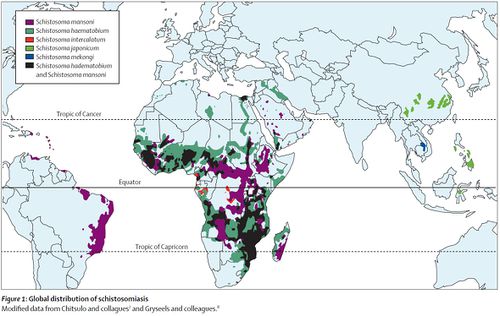Schistosomiasis
ナビゲーションに移動
検索に移動
| Navigation Menu |
| General issues of Vaccine | |||||||
|---|---|---|---|---|---|---|---|
|
| General issues of Travel med. | ||||||||
|---|---|---|---|---|---|---|---|---|
|
| Immunology | |||||||
|---|---|---|---|---|---|---|---|
|
| Epi & Stats | ||||||||||||
|---|---|---|---|---|---|---|---|---|---|---|---|---|
|
| Virus | |||||||||||||||||||
|---|---|---|---|---|---|---|---|---|---|---|---|---|---|---|---|---|---|---|---|
|
| COVID-19 | |||||
|---|---|---|---|---|---|
|
| Bacteria | ||||||||||||||||||||||
|---|---|---|---|---|---|---|---|---|---|---|---|---|---|---|---|---|---|---|---|---|---|---|
|
| Rickettsia | |||||
|---|---|---|---|---|---|
|
| Protozoa | ||||||||||||||||
|---|---|---|---|---|---|---|---|---|---|---|---|---|---|---|---|---|
|
| Fungi | |||||||
|---|---|---|---|---|---|---|---|
|
| Nematode (roundworm) | |||||||||||||||||
|---|---|---|---|---|---|---|---|---|---|---|---|---|---|---|---|---|---|
|
| Trematode (fluke, distoma) | |||||||
|---|---|---|---|---|---|---|---|
|
| Cestode (tapeworm) | ||||||
|---|---|---|---|---|---|---|
|
| Medical Zoology | ||||||||
|---|---|---|---|---|---|---|---|---|
|
目次
schistosoma is distinct from other trematoda
- trematode中schistosomaは他のtrematodeと異なる特徴を持つ
| schistosoma | other trematode |
|---|---|
| transmitted to human by percutaneous invasion of cercariae |
transmitted to human by oral ingestion of metacercariae |
| male and female separated 雌雄別体 | hermaphrodite雌雄同体 |
| does not require 2nd intermediate host (no metacercariae stage) |
requires 2nd intermediate host |
distribution
lifecycle
| Intermediate host | |
|---|---|
| Category | snails |
| Latin | Oncomelania nosophora 宮入貝 in Japan |
| Inward infection |
|
| Organ | snail tissue |
| Reproduction | asexual |
| Course |
|
| Detection | |
| Outward transmission | cercariae swim into freshwater in reaction to light (sunlight) |
| Definitive host | |
|---|---|
| Category | human being |
| Latin | |
| Inward infection |
|
| Organ |
|
| Reproduction | sexual (different from other trematodes) |
| Course |
|
| Detection |
|
| Outward transmission |
|
Schistosoma japonicum
- Katsurada Fujiro found 26 May 1904 from a cat in Yamanashi(水腫腸満)
- Fujinami Kan found 30 May 1904 from a murder victim in Katayama, Hiroshima(片山病)
- found egg in 1904 in Saga(奇病)
pathogenesis
- adult female paired by male migrate to messenteric vein from portal vein and lay eggs into messenteric venule, which are secreted from messenteric venule to intestinal lumen
- eggs also reach urinary bladder or genital tract and generate inflammation, followed by necrosis of tissue and perforation to intestine, resulted in extracorporeal distribution of egg via stool
- eggs are also distributed in liver and cause inflammation resulting in cirrhosis
- inflammation is exclusively due to egg
- adult pairs do not cause disease per se
co-infection
- HIV
- Typhoid
- Salmonella typhi has crossover antigenicity with Schistosoma and makes immune-tolerance against Schistosoma infection
- Also Salmonella hide between male and female schistosomes in the gynecophoric canal
- HepB/C
treatment
- praziquantel was discovered only in mid-1970s in Germany
- praziquantel only kills adult schistosoma
control
- In Japanese history before introduction of praziquantel, one of ways to control was eliminate intermediate hosts, snails - Oncomelania nosophora 宮入貝
- After introduction of praziquantel
- Malacological monitoring of snails in endemic area
- Improve water irrigation in order to avoid colonization of snails
- Effective screening of people in endemic area to detect actively infected patients
- Periodical mass drug administration to people in endemic area
- Praziquantel 30mg/kg twice for MDA
- Praziquantel 60mg/kg in two divided dose for detected patients
